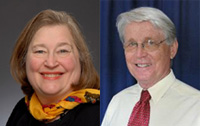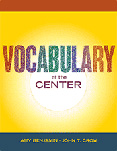
We recently spoke to education experts Amy Benjamin and John T. Crow about their new book, Vocabulary at the Center. Amy and John explain the most effective methods for extending the use of new words, so that vocabulary instruction can move beyond rote memorization.
VT: You gave your book the title, Vocabulary At The Center. What is it the center of?
AB: It's the center of being able to learn and the center of showing what you know. And it's the center of developing the mental capital that allows you to learn more.
VT: So it's like the medium in which we exchange knowledge?
AB: It's the currency.
VT: You make an interesting analogy in the book — that vocabulary is to academic learning what cardiovascular strength is to fitness.
JC: Yes, because the cardiovascular system drives fitness. Vocabulary really drives learning and the ability to show what you have learned. If students have the background knowledge to acquire information, but they can't tap into that background knowledge, then the educational experience is going to be very sparse at best. How do you tap into what we already know, what we've acquired, as human beings through our experience? You tap into it via vocabulary.
That is why vocabulary is truly at the center of education. A basic principle in education is that you build from known to unknown. How do you get into the known and give students something to attach to? You do it through vocabulary. All of our experiences are grouped around vocabulary. If I say the word dog, you're able to access not only the word and its meaning, but dogs that you may have had as pets in the past, pleasant or unpleasant experiences, what a dog feels like, what a dog smells like, different breeds of dogs. All kinds of information that you might have stored in your brain is organized under that one tag. All you have to do is access all of that. And that is why we consider vocabulary at the center.
Collateral learning is really important because it moves words into consciousness. That's what I love about the Visual Thesaurus, because I'm looking at the whole array of words there and they're kind of in the waiting room of my brain. If I'm a kid, maybe I've never heard of them but the next time I meet them, maybe they'll look a little bit familiar to me. It's that kind of collateral learning that I think is so worthwhile.
VT: We all agree that it's important to have students enrich their vocabularies so that they can open those gateways to communication. What about when students are forced to be judged on their vocabulary knowledge--like in the SAT, for example, or in other standardized tests? Is that a fair assessment?
AB: It's a tricky question. I do think that it's a fair assessment because a person's vocabulary means so much, in terms of their ability to learn more. And the SAT's putative function is to predict success at the college level. I certainly think that vocabulary knowledge is a great predictor of success at any academic endeavor, along with, of course, all kinds of other things external and internal. Now what, of course, is not fair is that not everybody has been taught vocabulary in effective ways.
JC: The standardized test, theoretically, measures the students' preparedness for college. Given equal exposure to reading material, to language experiences, the more intelligent of the population, insofar as we know how to measure intelligence, will pick up on more vocabulary and on the finer nuances of the vocabulary that they're exposed to. So in that sense, a vocabulary component is very fair as a test of not only preparedness — you need to have a good vocabulary to handle college reading material — but also of just general intelligence to see how much you have picked up of the vocabulary to which you've been exposed. If you're talking about social fairness, it's not fair, but nothing is.
VT: What can we do for those students who are not going to have those vocabulary-enriching experiences at home, where their vocabulary is not increasing by pure exposure?
AB: I think that it's very, very important for teachers, especially at the secondary level, to understand the idea of multiple exposure of words. If they can break down those firewalls that separate the math class from the science class from the social studies class from the English class and start to understand that we need to have kids exposed to a certain level of English for them to have academic success. We call it the GA, generic academic vocabulary, because those are the words that are in very high frequency in academic discourse but in low frequency in casual conversational discourse.
The normal person has a much larger passive or receptive vocabulary than they do active. So teachers need to understand this continuum, and work to move students along with those words that need to become part of their active vocabulary and be satisfied with passive recognition of a larger set of words that students will probably never need to use, necessarily — depending, of course, on their future educational directions.
As teachers, we need to understand the difference between words that are very important to know a lot about and words that are nice to know something about. My favorite example is the poem, "The Raven." I would get a vocabulary list for "The Raven," and it would have words in it like nepenthe and quoth. I would be treating those words like they were just as important as any of the other words on that or any other list. Meantime, these were kids that didn't necessarily know the word establishment. So we have to think about how we want to invest our vocabulary time, because time is always an issue.
I think it's very important for kids to be given the opportunity to have some ownership of the words and the extent to which they are going to commit to those words. We have a word learning chart that has four columns. It's a continuum of "How well do I know this word?" All the way over to the left is, "I never heard of this word," and all the way over to the right is "I already use this word." The idea is to have kids take some text and pick out some words that they would like to know more about and plot them on a chart like that and then have it be the goal that they're going to move those words over on the chart.
VT: You suggest students make those decisions and plot their own charts?
AB: I do. And then that turns into a formative assessment — and an authentic one — because what is it that we really know after kids have taken a vocabulary quiz? For one thing, maybe they already knew all of those words. And on the other hand, maybe they never heard of any of the words, but they learned a lot about them. But they didn't learn enough to pass the bar of that particular vocabulary test. That doesn't give us an accurate assessment of how much they learned. That's always a problem with assessments: what are they really telling us about the effects of time and instruction?
VT: What do you say to teachers who just say, "I don't have time for vocabulary, I have too much to go through"?
AB: I don't understand that. I do hear teachers say that. It doesn't really make sense to me because what is it that you can teach if the kids aren't developing their vocabulary? What is more important than vocabulary development?
JC: That, to me, is analogous to saying, "I don't have time to teach them to read, we have too much literature to cover."
Amy Benjamin, a veteran English teacher, trains educators throughout the country in writing across the curriculum, strategic literacy, and differentiated instruction. John T. Crow taught ESL, ESL methodology, applied linguistics, and freshman composition for over thirty years. To learn more about Vocabulary at the Center, please visit the Eye on Education website.


